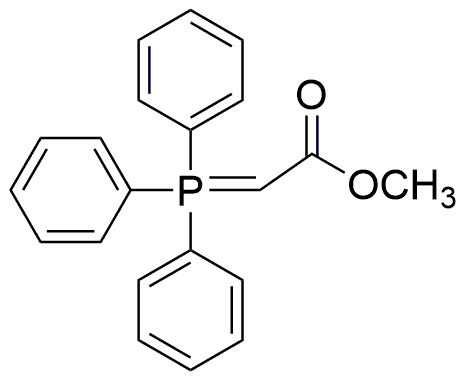Methyl (triphenylphosphoranylidene)acetate is widely utilized in research focused on:
- Synthetic Chemistry: This compound serves as a versatile intermediate in organic synthesis, facilitating the creation of complex molecules, which is essential for developing new pharmaceuticals and agrochemicals.
- Phosphorus Chemistry: It plays a crucial role in the study of phosphorus-containing compounds, helping researchers understand their properties and reactivity, which can lead to innovative materials and catalysts.
- Drug Development: In medicinal chemistry, it is used to design and synthesize potential drug candidates, particularly those targeting specific biological pathways, enhancing the efficiency of drug discovery processes.
- Material Science: The compound is explored for its potential applications in creating advanced materials, such as polymers and coatings, that require specific chemical properties for improved performance.
- Analytical Chemistry: It is utilized as a reagent in various analytical techniques, aiding in the identification and quantification of other chemical species, which is vital for quality control in pharmaceuticals and food industries.
General Information
Properties
Safety and Regulations
Applications
Methyl (triphenylphosphoranylidene)acetate is widely utilized in research focused on:
- Synthetic Chemistry: This compound serves as a versatile intermediate in organic synthesis, facilitating the creation of complex molecules, which is essential for developing new pharmaceuticals and agrochemicals.
- Phosphorus Chemistry: It plays a crucial role in the study of phosphorus-containing compounds, helping researchers understand their properties and reactivity, which can lead to innovative materials and catalysts.
- Drug Development: In medicinal chemistry, it is used to design and synthesize potential drug candidates, particularly those targeting specific biological pathways, enhancing the efficiency of drug discovery processes.
- Material Science: The compound is explored for its potential applications in creating advanced materials, such as polymers and coatings, that require specific chemical properties for improved performance.
- Analytical Chemistry: It is utilized as a reagent in various analytical techniques, aiding in the identification and quantification of other chemical species, which is vital for quality control in pharmaceuticals and food industries.
Documents
Safety Data Sheets (SDS)
The SDS provides comprehensive safety information on handling, storage, and disposal of the product.
Product Specification (PS)
The PS provides a comprehensive breakdown of the product’s properties, including chemical composition, physical state, purity, and storage requirements. It also details acceptable quality ranges and the product's intended applications.
Certificates of Analysis (COA)
Search for Certificates of Analysis (COA) by entering the products Lot Number. Lot and Batch Numbers can be found on a product’s label following the words ‘Lot’ or ‘Batch’.
*Catalog Number
*Lot Number
Certificates Of Origin (COO)
This COO confirms the country where the product was manufactured, and also details the materials and components used in it and whether it is derived from natural, synthetic, or other specific sources. This certificate may be required for customs, trade, and regulatory compliance.
*Catalog Number
*Lot Number
Safety Data Sheets (SDS)
The SDS provides comprehensive safety information on handling, storage, and disposal of the product.
DownloadProduct Specification (PS)
The PS provides a comprehensive breakdown of the product’s properties, including chemical composition, physical state, purity, and storage requirements. It also details acceptable quality ranges and the product's intended applications.
DownloadCertificates of Analysis (COA)
Search for Certificates of Analysis (COA) by entering the products Lot Number. Lot and Batch Numbers can be found on a product’s label following the words ‘Lot’ or ‘Batch’.
*Catalog Number
*Lot Number
Certificates Of Origin (COO)
This COO confirms the country where the product was manufactured, and also details the materials and components used in it and whether it is derived from natural, synthetic, or other specific sources. This certificate may be required for customs, trade, and regulatory compliance.


